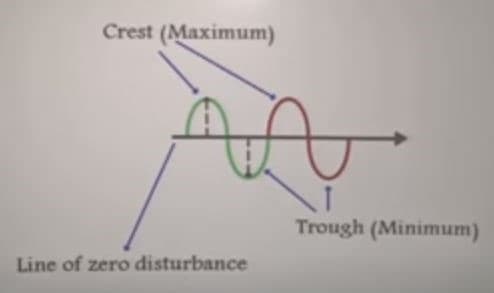The disturbance due to which energy is transferred from one place to another without transferring mass is known as wave. Depending upon the conditions a wave may be transverse or longitudinal. Basically, transverse and longitudinal waves are the types of progressive waves.
Progressive Waves
Progressive waves are those waves which transfers the energy from the point where the disturbance has been created. For example, take a water tub and drop a stone at one side of the tub containing water. The disturbance will be created in the water. This disturbance is basically in the form of waves which carry the energy from the point where the stone was dropped to the other end. These energy carrying waves are called progressive waves.
Progressive waves are further classified on the basis particles/molecules movement either the molecule propagate in the direction of wave or propagate perpendicular (at an angle of 90°) to the wave.
Demonstration of transverse waves
Suppose two persons holding the rope at the opposite ends and by any reason one person gives up and down jerk to the rope. The jerk creates a mound in the rope which travels towards the other person along with the rope. The hump reaches to other end of the rope where the second person is standing this hump apply a force on the hand of the other person which causes his hand to move up and down.
The hump which was created by the first person reaches to other end carrying momentum and energy through a medium which is a rope. A moving hump acts as a wave in the rope. This type of wave is known as pulse. The movement of the pulse in the forward direction from one person to the other is an example of progressive wave. The source of the wave in the rope is the jerk given by the first person. The rope is the medium in which wave moves.
Demonstration of longitudinal waves
To demonstrate the effect of the motion of the source A large and loose spring coil (slinky spring) can be used in generating waves in a medium. The spring is place on a smooth surface like table and one end of the spring is tied so that there is no effect of gravity on it.
A pulse of wave having a displacement pattern will be generated which will move along the spring if the free end of the spring is vibrated from side to the other side. Displacement will travel along the spring if the ends of the spring is moved back and forth, along the direction of the spring itself a wave with back and forth. Waves like those in which displacement of the spring is perpendicular to the direction of the waves are called transverse waves.
Waves like those in which displacements are in the direction of propagation of waves are called longitudinal waves. In this example the coil of spring is the medium, so in general we can say that.
Transverse waves
Transverse means extending across something or crosswise. Transverse waves are those waves in which particles of medium propagate perpendicularly to the direction of wave. Here the particles move up and down as the wave moves.
As in transverse waves the particles vibrate up and down in their mean position so the maximum displacement on either side of the mean position is known as amplitude. The maximum positive displacement of particles from their mean position is known as crust. The maximum negative displacement of the particles from the mean position or the minimum displacement of the particles from their mean position is known as trough and the mean position is known as line of zero disturbance.
Longitudinal waves
Longitudinal means running lengthwise. Longitudinal waves are those waves in which particles of the medium propagate parallel to the direction of the wave.
In longitudinal waves compressions and rarefactions occur as shown in the picture below. The parts of the slinky which come together are known as compressions. As the compressions move ahead it leaves behind the parts of the slinky which are far away from one another this is known as rarefactions. Compressions take place when the particles become dense and rarefactions take place when the particles are far apart from one another.
Transverse and longitudinal waves can be propagated in solids. In fluids, however, transverse waves die out very quickly and usually cannot be produced at all. That is why, sound waves are also called as longitudinal waves.
Comparison of transverse and longitudinal waves
Transverse waves act or move in two dimensions while longitudinal waves act or move in one direction. In transverse waves medium particles move perpendicular to the wave while in longitudinal waves Medium particles move parallel to the wave. Transverse waves can only be produced in liquids and solids whereas, longitudinal waves can be produced in all forms of matter i.e., solid, liquid and gas.
Transverse waves can be polarized or aligned while longitudinal waves cannot be polarized or aligned. In transverse waves medium moves up and down while the wave moves left to right whereas in longitudinal waves medium moves left and right and waves moves from left to right hand. Example of transverse waves is wave in a string while sound waves are the examples of longitudinal waves.
















